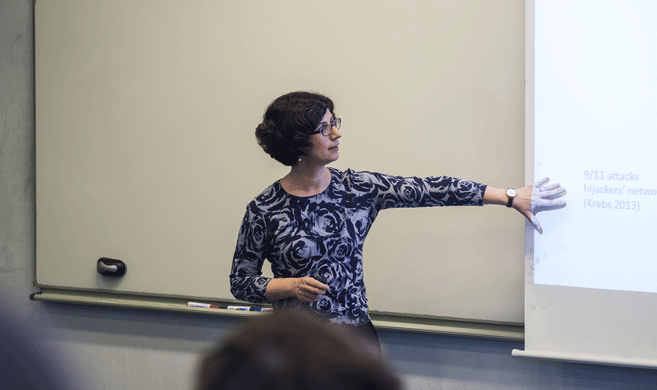Knowledge@HEC: First, what challenges do women and minorities face at work?
Elena Lizunova and Denisa Mindruta: In entrepreneurship, one of the most well-documented gaps is the gender gap: women are less likely to become entrepreneurs, less likely to attract external capital, and less likely to scale up their ventures. We wanted to know what drives these gender disparities, so we set out to study female entrepreneurs in male-dominated industries—industries where women are a minority and might face additional challenges. Our research shows that in the first three years after venture creation, women-led ventures perform financially as well as those founded by men. Yet, surprisingly, when it comes to male-dominated industries, female founders tend to leave entrepreneurship at higher rates than men.
Our research shows that in the first three years after venture creation, female founders operating in male-dominated industries tend to leave entrepreneurship at higher rates than men, although we do not observe these women underperforming.
We also observe that the entrepreneurial process unfolds differently for both genders. Women report encountering more challenges such as financing problems and difficulties recruiting qualified staff. As founders, they start with a disadvantage in terms of pre-existing connections with clients, suppliers, and former employers. It is interesting to note that in female-dominated industries, the exit rates for the two genders are similar and women do not report having more difficulties, although they also report having fewer connections than men.
Roxana Barbulescu: Women are often penalized in their career outcomes (think salary or promotions) relative to men, but this is not always the case. In fact, there are situations when at least some women have an advantage, and it is important for research to uncover the conditions in which this happens. In ongoing research, Wooseok Jung and I are using a large-scale longitudinal dataset on the careers of law firm graduates in the US. This allows us to see how the career outcomes for male vs female lawyers differed around the 2008 financial crisis. We find that while women lawyers were more likely than men to miss promotions and incur compensation decreases overall, this penalty reversed for female graduates of elite law schools. These women did better than their male equivalents at maintaining their promotions and compensation in face of the crisis.
There are situations when at least some women have an advantage, and it is important for research to uncover the conditions in which this happens.
However, and importantly, we also found that this advantage only occurred when the women worked in certain kinds of organizations and jobs – for example, firms with a high percentage of female workforce, and jobs with high autonomy and output responsibility. Thus, the advantage for women from the elite universities, while real, seems contingent on enabling features of the employing organization. In sum, our research suggests that only by considering several factors at different levels – the individuals’ educational background as well as conditions in the current employing organizations –can we fully understand what drives different career outcomes for diverse groups.
Why did women from elite schools maintain their promotions and compensation better than men during crises?
Roxana Barbulescu: Unfortunately, the data do not allow us to see very clearly why this is happening. If I were to guess, I would say that one or more of the following may be happening: the women graduating from top schools could be exceptionally good (at the margin, better than the equivalently trained men), or they may get hired by firms that have better career management tracks for women, or maybe they are treated with particular care by these firms because of their pedigree – they are “rare pearls” to have in the workforce. We are currently trying to disentangle these explanations. But what the data do tell us for sure is when this educational advantage is more or less strong.
Why is it important to have more women in male-dominated industries?
Elena Lizunova: Women are known to care about social impact, so having more women in usually male-dominated industries could lead to more sustainable solutions. It would also lead to more inclusive solutions because when men (or any other group that is not diverse) come up with solutions, those solutions only address the needs of the group that found those solutions (men in this case), which excludes the different groups.
Women are known to care about social impact, so having more women in those industries could lead to more sustainable and inclusive solutions.
This is why we look at industries that have a high potential for growth and innovation, because most of them are male dominated and because they impact the world. For example, industries like programming are male dominated and use technologies that could have a lot of impact on the world, but women are underrepresented there (about 10% of all founders are women).
Roxana Barbulescu: Almost half of the discrepancy in income among women and men comes from the allocations of people to jobs – men and women take jobs in different occupations. On average, male-dominated industries or occupations pay more (sometimes, a lot more) than their women-dominated counterparts, and the highest paying jobs and occupations in our society are all male dominated. So it is also important to have more women in male-dominated industries to decrease the inequality in our society between women and men in terms of pay and wealth.
What is the role of Human Resources in recruiting diversity?
Shaheena Janjuha-Jivraj(1): The Diversity & Inclusion agenda is a change agenda and so responsibility for momentum across this area runs across the organization. D&I cannot sit solely with Human Resources (HR), in fact when this happens, D&I initiatives are less likely to succeed. HR is perfectly placed to mobilize the D&I agenda, by ensuring the hard-wiring is in place. The robust policies are established but more importantly, the soft-wiring, in other words an inclusive culture where leaders become more comfortable working with diverse teams. Using an evidence-based approach is critical for successful D&I strategies. Policies implemented need to have clear KPIs in place that provide interim measures that shape behavior and attitudinal change – with a particular focus on middle managers to unlock the pipeline.
Roxana Barbulescu: I agree with Shaheena. People’s career decisions are not instantaneous but rather shaped by long-lasting impressions of different employers and the anticipation of how their careers will unfold in different workplaces. For instance, in one of my papers(2) I studied the job search process and decisions of 1,200 MBA participants from an international program. I looked in particular at the extent to which women and men’s different post-MBA job outcomes were due to differences in application behavior and/or differences in offers received. The findings revealed strong application differences by gender. Overall, women were less likely than men to apply to jobs in finance and consulting, and more likely to apply to jobs in general management.
The reputation of their workplace among potential employees requires sustained, long-term efforts to improve and maintain their internal culture and career management practices to appeal to diverse talent.
These differences were explained by women’s explicit preference for jobs with better anticipated work–life balance, their lower identification with stereotypically masculine jobs, and their lower expectations of job offer success in such stereotypically masculine jobs. Women were also less likely to receive job offers to any type of job once they applied, meaning that their application behavior directly shaped the final job outcome differences, with relatively fewer women than men in this setting entering finance and consulting jobs. For the employers, the lessons are sobering. Organizations cannot reasonably expect that cosmetic changes to their recruiting campaigns, for instance, will translate into immediate results in diversity hiring. The reputation of their workplace among potential employees requires sustained, long-term efforts to improve and maintain their internal culture and career management practices to appeal to diverse talent.
What is an inclusive leadership?
Shaheena Janjuha-Jivraj: Inclusive leadership is a conscious approach to creating stronger connections within diverse teams. Recruiting diversity is the first step in building diverse teams. The real value from diversity occurs through innovation which happens when colleagues form strong bonds of trust leading to creative thinking. An inclusive leader will nurture an environment where teams feel safe and willing to take risks with their thinking, challenge group think and ultimately emerge with strong, new ideas. Building inclusive leadership leads to a pluralistic form of leadership, where cognitive diversity flourishes.
Valérie Gauthier: Human beings are fundamentally relational beings. The fear of what is different, of the unknown, of the stranger tends to push humans towards what is similar to them. However, in our current research we find that the further apart two individuals are on paper (cultural, age, race, gender or educational differences), the more efforts each one of them has to make to understand the other, and the more each individual will learn about her/himself on the way. Because all human beings have something in common: they are human. Therefore, training towards opening up to others, welcoming their diversity, and valuing their differences becomes an asset in a leadership style that creates the conditions for those differences to work together with respect and understanding. This training has a name and a methodology: the Savoir-Relier (3). And it works!
The further apart two individuals are, the more efforts each one of them has to make to understand the other, and the more each individual will learn about her/himself on the way.
What makes boards more diverse?
Valérie Gauthier: Organizations that create an environment where different profiles collaborate and have room for initiative and self-expression will perform better. Introducing processes whereby a deep understanding of the other person whatever the difference will enrich the quality of work and performance. Leading by example, when boards make conscious efforts to bring diversity inside by recruiting diverse profiles, the rest of the organization will follow. Those efforts include developing women and culturally diverse people inside the organization as well as recruiting internationally and outside the educational stream they are used to working with. A company that includes interdisciplinary profiles with mixed gender and applies methods to generate collaborative and genuine understanding of the way each individual operates, will be more successful.
What makes companies more or less inclusive to employees with disabilities?
Marieke Huysentruyt and Leandro Nardi: There is not much research in management or strategy on inequalities concerning persons with disabilities. So we are excited to start a project (with Thomaz Teodorovicz of Harvard University) to understand what makes companies more inclusive to employees with disabilities. We use a very large dataset containing every formal labor contract in Brazil. We will explore several firm characteristics that may explain these superior capabilities, including companies' inclusiveness in other dimensions (such as gender, race, income).
We need to understand whether some firms are “better” at employing persons with a disability.
In essence, our project exploits the introduction of a series of measures that the Brazilian government undertook to increase firms’ demand for individuals with a disability. We have access to the population of all formal labor contracts at the firm-individual level, meaning we can really track how people’s labor market situation evolves over time to understand whether some firms are “better” at employing persons with a disability: “better” in terms of the wage inequality, increasing wages, upward career trajectories, etc.
Can you share some insights on how to make the best of opportunities in various organizations?
Valérie Gauthier: Learn to question yourself and remain open to different, diverging and opposing views by coming down your ladder, dropping the mask and working outside your prejudices, beliefs and assumptions. Listen to the music you don’t like, eat the food you don’t know, discover the art you perceive as crazy and engage in conversations with people who think differently from you with a genuine openness. You will learn from those differences and you will build your own style in your own and unique differences with the serene confidence of being who you are, bringing your own value and building sense for yourself and the organization.
Shaheena Janjuha-Jivraj: Through my research and extensive work with companies, I have found two things that are game changers for women’s careers; championing by a senior leader and the opportunity to take on a stretch role (Ed, jobs for which you perhaps have most of the required experience but not all). Championing is less transactional than sponsorship and occurs when senior leaders invest in identifying talented individuals who don’t have a strong presence in leadership roles. Champions see the potential in individuals, and work with them to take on new roles. Championing works well with stretch roles, where individuals take on opportunities that are beyond their comfort zone but help to build confidence in their abilities for their career progression.
John Mawdsley and Rodolphe Durand: Many scholars and industry practitioners outline a “business case” for diversity whereby improving diversity, as one form of prosocial action, can improve a firm’s reputation and help it attract new employees and customers. It’s a sad story, (and may not even provide the anticipated benefits to firm or worker) but essentially, a firm’s drive for higher profits can lead to opportunities for women and minority workers.
In our latest research(4) in the US corporate legal services sector, we find that most large US corporate law firms increase their number of female partners in response to the clients of their rival law firms increasing gender diversity in their executive team. These law firms, we propose, do this to send a “signal” to those clients that they share the same pro-diversity values. But, our findings indicate that law firms may manage their diversity levels in a calculated, strategic way. While we might prefer career opportunities to not be influenced by client and customer preferences, many firms often look first to improving profits rather to improving prosocial action.
In that context, what do you recommend to women and minorities for their career?
John Mawdsley: It seems that for women and minorities, the expectations or preferences of clients and customers for greater diversity can provide career opportunities for women and minority workers in firms that provide products and services to clients and customers that they may not have otherwise received. I invite you to check Professor Sarah Kaplan’s Institute for Gender and the Economy online.
Gender traits stereotypes: what impact on gender equality at work?
Shaheena Janjuha-Jivraj: We have enough evidence to demonstrate the impact of systemic biases that impact career progression for women. A great deal of work has focused on addressing the policies and structural inequalities at work, but we need to pay more attention to cultural attitudes. The global pandemic has impacted career progression for women and the companies that have embedded D&I into their DNA are more agile and likely to retain women employees. We need to remember the focus needs to stay on fixing the organization rather than fixing the women.
The global pandemic has impacted career progression for women and the companies that have embedded D&I into their DNA are more agile and likely to retain women employees.
Education is critical both in the formal sense leading to qualifications and information through experiential opportunities. Learning new knowledge, testing it and developing new ways of behavior – these create the opportunity for individuals to develop their confidence as they apply leadership in different contexts. Our world today is filled with complex problems, so-called wicked problems, where we don’t have a simple solution and need creative solutions and trust in our thinking to speak up and share different thoughts.
Bianca Crivellini Eger: First, I believe that, based on research1, traits don’t have a gender. But the assumption that a certain gender holds specific traits is alive and well, and this is fundamental in social perception and judgment. In my current research(5), I find that even in male-dominated industries, the closer males are to 25 years old, the more comfortable they are displaying traits that are stereotypically feminine, but also, the more they get marginalized.
Despite consolidated research2 showing that the most effective leaders are not hegemonic leaders but hold a lot of “feminine” traits, many of the barriers of the advancement of women and men said “feminine” in the workplace are still the consequences of gender stereotypes. Allowing these gender stereotypes to survive is counterproductive for professional women, for the new professional men, and for companies alike.
What can companies do to prevent this marginalization based on gender traits stereotypes and to contribute to the achievement of gender equality?
Bianca Crivellini Eger: Companies should leverage the new mentality being fostered by society, the image of the new more “feminine” man. If companies could normalize and encourage what is defined as feminine traits, hence removing the assumptions tied to gender stereotypes, this could go a long way to promoting gender equality in the workplace and to leave behind the traditional Don Draper-type professional alpha male, who is already becoming obsolete in society.
Concretely, a simple implementation like reframing the requirements and description of leadership positions and other job descriptions could be very powerful in changing the optics tied to gender in the workplace. If companies begin to highlight the essential “female” qualities that a leader should possess and display, this would quickly cascade to the lower levels of the corporate ladder, fostering a mentality of inclusiveness and gender equality.
Reframing the requirements and description of leadership positions and other job descriptions could be very powerful in changing the optics tied to gender in the workplace.
In fact, if leaders are explicitly encouraged and expected to be sensitive, accountable, and empathetic, lower-level employees (men and women alike) displaying these traits would feel comfortable displaying them and would not be discriminated against. This would result an inclusive workplace.
How to implement change through training and education?
Valérie Gauthier: More than training, education is the source of change, as long as the right mindset is in place for people to learn not only from science and other subjects but also from each other, from different perspectives and ways of understanding, from introducing more sense and sensibility in the way we teach and learn. Therefore, rather than formatting people, education settings must be interdisciplinary and sensible to create collaborative environments where individuals can express their original perceptions and not just their opinions and thoughts and be respected for them.
Thomas Åstebro: Your family background has probably the largest impact on your future career, education comes second to that. Education can forever change individuals' opportunities, releasing them from the shackles of poor socio-economic conditions. First, education trains you - you acquire skills. Research by Abhijit Banerjee, Esther Duflo and Michael Kremer (earning the 2019 Nobel Memorial Prize in Economic Sciences) shows that access to basic education in developing countries such as India and states in Sub-Saharan Africa is key to those nations' future success. It also provides a signal of ability, and that signal may be as powerful as the training, especially if you go to a highly reputable school.
The type of training also matters, but probably less so. If you want to become an entrepreneur, whether you go through an Entrepreneurship Master or a Marketing Master is likely to matter much less than the difference between getting a Master’s degree and not getting one.
A small nudge at a young age may have a pivotal impact on careers.
Women in science are severely underrepresented, and this has to do more with deeply rooted norms in society and subjective beliefs than preferences. A small nudge at a young age may then have a pivotal impact on careers. Indeed, Thomas Breda at Paris School of Economics and colleagues showed that a one hour visit by a woman scientist to a Paris high school had a significant impact, increasing the likelihood that a young female would change her career choice to apply and get admitted to a STEM-based university program. And young female high school students in Ecuador who watched a one-and-a-half hour set of videos of women scientists and entrepreneurs showed a 13% increase in interest in studying science at university.
How can we imagine the future of work with more D&I?
John Mawdsley: The increased adoption of remote work and Working from Anywhere (WFA) organization policies has the potential to increase diversity and inclusion. WFA especially (where employees work remotely and can live in any geographic location) can provide huge benefits. For example, in dual career couples it is often the wife’s career that is compromised through the family moving to a new location because of the husband’s job. WFA would allow the wife to keep her job regardless of where the family moved to. Similarly, women are not constrained by location when applying for jobs in companies with WFA policies, so it could open more career opportunities.
Remote work can provide greater flexibility to fit work around important family commitments, and allow more workers in general, and women in particular, to remain with their employer rather than having to quit work.
In addition, remote work can provide greater flexibility to fit work around important family commitments that might be difficult otherwise. This should allow more workers in general, and women in particular, to remain with their employer rather than having to quit work. So, D&I policies could increase as companies downsize their office footprint and allow employees to perform their role remotely. (See the presentation by Prithwiraj (Raj) Choudhury of Harvard Business School on WFA, in this seminar I moderated.)
Shaheena Janjuha-Jivraj: D&I is no longer “nice to have”, it’s a business imperative; progressive companies are moving beyond diversity recruitment issues towards building equity, inclusions and even pluralistic cultures.
Diversity is about being invited to the party, inclusion is being asked to dance, pluralism is when everyone learns each other’s dances – when we learn new things, we make new connections, and the quality of our thinking improves.
Diversity is about being invited to the party, inclusion is being asked to dance, pluralism is when everyone learns each other’s dances.
***
(1) Shaheena Janjuha-Jivraj (HEC Paris), author of “Championing Women Leaders” and upcoming “Futureproofing Your Career” (Fall 2021). See her Forbes article).
(2) Roxana Barbulescu (HEC Paris) and Matthew Bidwell (Wharton University), “Do Women Choose Different Jobs From Men?” (Organization Science, 2013). Summary on Knowledge@HEC.
(3) Valérie Gauthier (HEC Paris), author of “Leading With Sense: The Intuitive Power of Savoir-Relier”, Stanford University Press 2014. Learn more and read the interview with Valérie Gauthier.
(4) John Mawdsley (HEC Paris), Lionel Paolella (Cambridge Judge Business School, PhD at HEC Paris) and Rodolphe Durand (HEC Paris), "A Competitive-Based Conformity Explanation of Firms’ Prosocial Behavior: The Case of Gender Diversity in Professional Service Firms".
(5) Bianca Crivellini Eger (PhD student at HEC Paris), “Men become more “feminine”: what impact on gender equality at work?” (working title).
1
-
Abele, A. E. (2003). The dynamics of masculine-agentic and feminine-communal traits: findings from a prospective study. Journal of personality and social psychology, 85(4), 768. – Gender stereotypes are pervasive in spite of the changing roles of men and women.
-
Costa Jr, P. T., Terracciano, A., & McCrae, R. R. (2001). Gender differences in personality traits across cultures: robust and surprising findings. Journal of personality and social psychology, 81(2), 322. – Showing that gender/trait differences vary across cultures (suggesting that the difference is socially constructed)
-
Rudman, L. A., & Glick, P. (2001). Prescriptive gender stereotypes and backlash toward agentic women. Journal of social issues, 57(4), 743-762. – investigating the figure of agentic women
2
-
Rosette, A. S., & Tost, L. P. (2010). Agentic women and communal leadership: How role prescriptions confer advantage to top women leaders. Journal of Applied Psychology, 95(2), 221.
-
Bass, B. M., & Riggio, R. E. (2006). Transformational leadership.





















